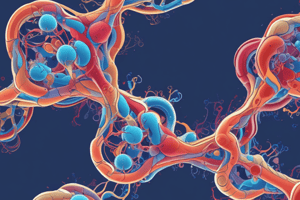Podcast
Questions and Answers
What is the role of catabolism in metabolism?
What is the role of catabolism in metabolism?
- To degrade enzymes
- To provide energy and building blocks (correct)
- To build large molecules
- To synthesize ATP
Enzymes are permanently altered during a chemical reaction.
Enzymes are permanently altered during a chemical reaction.
False (B)
What is the term for the sum of the chemical reactions in an organism?
What is the term for the sum of the chemical reactions in an organism?
Metabolism
Anabolic reactions involve _______________________ synthesis.
Anabolic reactions involve _______________________ synthesis.
Match the following terms with their definitions:
Match the following terms with their definitions:
What is the role of ATP in coupling reactions?
What is the role of ATP in coupling reactions?
All metabolic pathways are determined by enzymes.
All metabolic pathways are determined by enzymes.
What is the term for a sequence of enzymatically catalyzed chemical reactions in a cell?
What is the term for a sequence of enzymatically catalyzed chemical reactions in a cell?
Enzymes are specific for a _______________________ reaction.
Enzymes are specific for a _______________________ reaction.
What is the term for a biological molecule that can catalyze a chemical reaction?
What is the term for a biological molecule that can catalyze a chemical reaction?
Flashcards are hidden until you start studying
Study Notes
Enzyme Components
- Apoenzyme: Protein component of an enzyme
- Cofactor: Nonprotein component of an enzyme
- Coenzyme: Organic cofactor
- Holoenzyme: Apoenzyme plus cofactor
Electron Carriers
- Assist enzymes in their functions
- Examples: NAD+, NADP+, FAD, Coenzyme A
Enzyme Classification
- Oxidoreductase: Catalyze oxidation-reduction reactions
- Transferase: Transfer functional groups
- Hydrolase: Catalyze hydrolysis reactions
- Lyase: Remove atoms without hydrolysis
- Isomerase: Rearrange atoms
- Ligase: Join molecules, using ATP
Factors Influencing Enzyme Activity
- Temperature:
- Optimal range: Enzymes function best at a specific temperature range
- High temperature: Increases activity up to a point, but extreme heat denatures enzymes
- Low temperature: Slows down enzyme activity without causing denaturation
- pH:
- Optimal pH: Each enzyme has an optimal pH where it is most active
- Deviation: Changes in pH can alter enzyme structure and function, potentially leading to denaturation
- Substrate Concentration:
- Low concentration: Increasing substrate levels boost enzyme activity
- Saturation point: Beyond a certain concentration, enzyme activity plateaus as all active sites are occupied
Inhibitors
- Competitive Inhibitors: Compete with the substrate for the active site; effect can be reduced by increasing substrate concentration
- Non-Competitive Inhibitors: Bind elsewhere on the enzyme, changing its shape and reducing activity
- Uncompetitive Inhibitors: Bind only to the enzyme-substrate complex, lowering both the reaction rate and substrate affinity
- Allosteric Inhibitors: Bind to an allosteric site, causing conformational changes that decrease enzyme activity
Energy Production
- Metabolism: The sum of the chemical reactions in an organism
- Catabolism: Provides energy and building blocks for anabolism; involves degradative reactions that are generally hydrolytic, exergonic, and provide energy and building blocks
- Anabolism: Uses energy and building blocks to build large molecules; involves biosynthetic reactions that are generally dehydration synthesis, endergonic, and require energy
Role of ATP in Coupling Reactions
- ATP is an intermediate between catabolism and anabolism
- ATP is generated in catabolic reactions and used in anabolic reactions
Studying That Suits You
Use AI to generate personalized quizzes and flashcards to suit your learning preferences.




